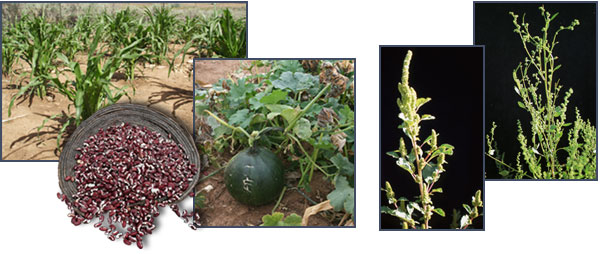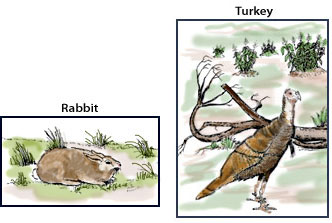Peoples of the Mesa Verde Region
The Pueblo III Period: A.D. 1150 to 1300Food
Wild plants and animals continued to supplement the Pueblo diet of corn, beans, and squash during this time. Weedy plants that grew readily in agricultural fields were eaten in great quantities, and rabbits were the most commonly consumed wild game. Archaeological evidence suggests that larger animals, such as deer, elk, and bighorn sheep were not eaten as often as they had been during earlier periods, which suggests that they may have been over-hunted in the areas surrounding the large villages. Consumption of corn-fed turkey, on the other hand, seems to have greatly increased during the Pueblo III period. 
During the Pueblo III period, people supplemented their diet of corn, beans, and squash (left) with a variety of wild, weedy plants such as amaranth and goosefoot (right). 
Rabbits and domesticated turkey were the primary sources of animal protein during the Pueblo III period, as deer and other large game grew scarce. From A.D. 1276 through A.D. 1299, a severe drought affected parts of the Southwest, including the Mesa Verde region. The drought undoubtedly caused hardship, including food shortages, among the Pueblo farmers. Yet, archaeological evidence suggests that this drought was not as severe as the one that occurred during the Pueblo II period, and it appears that people were still able to grow corn in some locations. Not surprisingly, the use of checkdams, farming terraces, and reservoirs became more common during the Pueblo III period, as people were faced with growing enough food to feed the large numbers of people that had congregated in villages.
Read about a Pueblo III cistern at Mesa Verde National Park. |
|
Acknowledgments | Illustration credits | To borrow, cite, or request permission | Please take our survey! Title page for Peoples of the Mesa Verde Region |
|
 DONATE TODAY
DONATE TODAY
